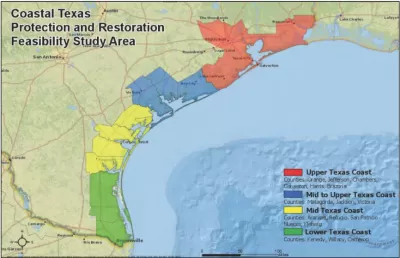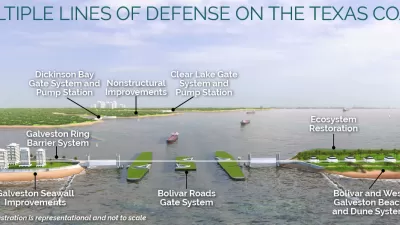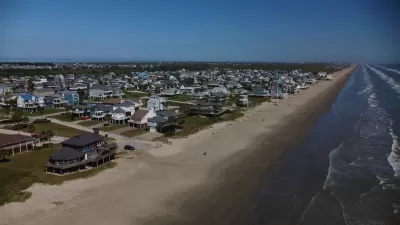The U.S. Army Corps of Engineers has proposed a suite of coastal infrastructure projects—i.e., floodgates and seawalls—to shore up the coast of Texas against Hurricane- and sea level rise-aided water.

"Following years of research, studies and public debate, the U.S. Army Corps of Engineers — in partnership with the state’s General Land Office — has recommended a multi-billion-dollar project that would protect the Houston area and its massive industrial complex from hurricane storm surge," reports Kiah Collier.
The Army Corps selected a final plan from four alternative proposals [pdf], with varying configurations of levees, seawalls, and locks, according to Collier, settling on a plan originally called the Ike Dike, but now called the "coastal spine."
The sweeping plan calls for the construction of a levee along Galveston Island and the peninsula to its north, Bolivar, as well as the installation of a gate between the two isles to keep storm surge from pouring between them into Galveston Bay and the Port of Houston. It also includes improvements to Galveston's existing seawall and a “ring levee” around the heart of the city. Such a structure would protect the backside of the most densely populated area from surge and flood waters retreating to the Gulf of Mexico following a storm.
The Army Corps "also identified extensive 'non-structural improvements' — such as beach renourishment and dune restoration — for much of the Texas coast," adds Collier.
FULL STORY: Army Corps, Texas officials propose sweeping hurricane protection plan

Manufactured Crisis: Losing the Nation’s Largest Source of Unsubsidized Affordable Housing
Manufactured housing communities have long been an affordable housing option for millions of people living in the U.S., but that affordability is disappearing rapidly. How did we get here?

Americans May Be Stuck — But Why?
Americans are moving a lot less than they once did, and that is a problem. While Yoni Applebaum, in his highly-publicized article Stuck, gets the reasons badly wrong, it's still important to ask: why are we moving so much less than before?

Using Old Oil and Gas Wells for Green Energy Storage
Penn State researchers have found that repurposing abandoned oil and gas wells for geothermal-assisted compressed-air energy storage can boost efficiency, reduce environmental risks, and support clean energy and job transitions.

Minneapolis Bans Rent-Setting Software
Four cities have enacted restrictions on algorithmic software that can inflate rent costs.

Oakland to Add 244 New EV Chargers
Oakland plans to launch its new charging network at eight locations by the end of 2025.

Jane Goodall Inspires with Message of Hope, Resilience, and Environmental Action
Speaking in Pasadena, Jane Goodall offered a hopeful and inspirational message, urging global compassion, environmental responsibility, and the power of individual action to shape a better future.
Urban Design for Planners 1: Software Tools
This six-course series explores essential urban design concepts using open source software and equips planners with the tools they need to participate fully in the urban design process.
Planning for Universal Design
Learn the tools for implementing Universal Design in planning regulations.
Heyer Gruel & Associates PA
City of Moreno Valley
Institute for Housing and Urban Development Studies (IHS)
City of Grandview
Harvard GSD Executive Education
Salt Lake City
NYU Wagner Graduate School of Public Service
City of Cambridge, Maryland




























